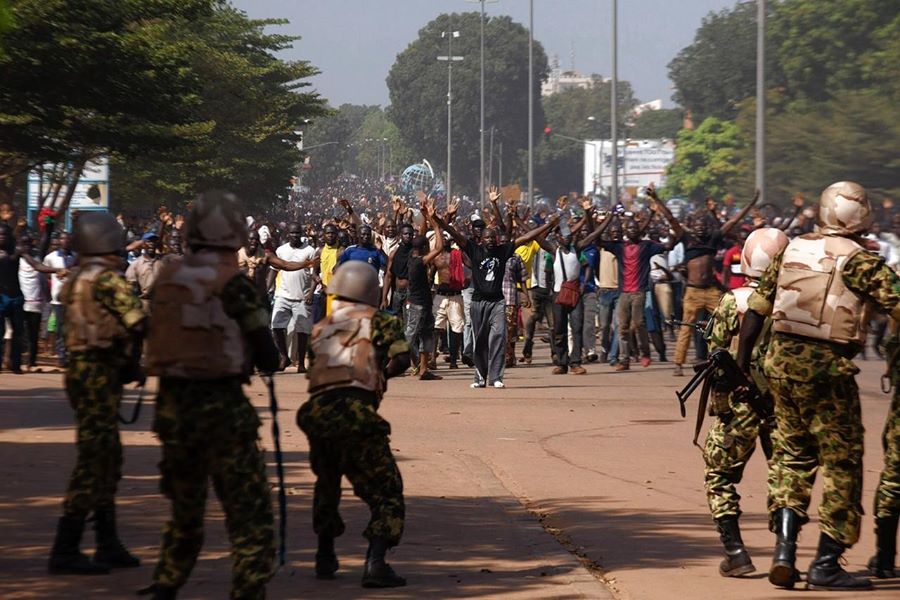The revolutionary overthrow of Blaise Compaoré on 31 October 2014 was a fundamental turning point for Burkina Faso. It brought an entire country to its feet. It released pressures which have been accumulating for decades. After being under the jackboot of the Compaoré counterrevolution for 27 years, the masses of the “Land of the Upright People” have dramatically entered the stage of history. The transitional government which filled the gap left by Compaoré’s departure has been a regime of turmoil and crises. At bottom, this is as a result of pressures from the mass movement. Now, after months of turmoil, the ruling class is desperately trying to channel the situation into some kind of bourgeois democratic order. But the elections, scheduled for 11 October, will change nothing fundamental for the masses. It will only serve as a new stage for the struggle.
Strike wave
The downfall of Blaise Compaoré has left behind a country which is characterised by daily strikes, protests and mass mobilisations of workers, students and the poor. All over the country, key questions such as access to land, forceful resettlements, agriculture, land disputes, mining disputes, corruption and the state of public facilities are very often at the centre of spontaneous revolts. Over the last year there has been an explosion of strikes and mass protests. Emboldened by the popular uprising, villagers and workers have taken to mass action to improve their lives.
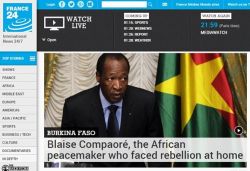 In January, workers at the country’s main brewery, Brakina Sodibo, embarked on a 48-hour warning strike. The workers were demanding a salary increase, the reinstatement of workers who were irregularly sacked in 1994 and 2004 and for better working conditions among other demands. Later, after weeks of struggle, most of the demands of the workers were met.
In January, workers at the country’s main brewery, Brakina Sodibo, embarked on a 48-hour warning strike. The workers were demanding a salary increase, the reinstatement of workers who were irregularly sacked in 1994 and 2004 and for better working conditions among other demands. Later, after weeks of struggle, most of the demands of the workers were met.
On 8 April, a national coalition against corruption and the high cost of living, held a mass protest in Ouagadougou. This coalition included trade unions, student bodies and civil groups. More than 50 000 people marched through the streets. Schools and universities were forced to close as the city was brought to a standstill.
Again on 22 April, protesters barricaded the Ouagadougou-Kaya road in Ziniare with traffic coming to a standstill in both directions. On 30 April, in Sabce, 90 kilometers north of the capital, residents demanded the appointment of a new mayor after having forcibly chased away the old one. Then on May Day, an even larger march again brought the capital to a complete halt with protesters demanding that the transitional government take immediate action to address the high cost of living.
Over the last year many disputes have rocked the country’s mining industry. Gold mining developed rapidly in the West African country. According to the IMF, gold exports account for three-quarters of exports within the last five years. The metal has replaced cotton as the country’s biggest source of income. Hundreds of thousands of small-scale miners working in the industry. The country exported 36 metric tons of gold last year, worth $1.4 billion at current prices.But this mining boom has fuelled social tensions because it hardly contribute to local development. For many years, this has caused deep resentment with local communities.
But the revolution has given fresh impetus to the struggles of workers and communities. In December, workers occupied the Avocet Inata gold mine and blocked management’s access. In February, protesters smashed equipment and set fire to vehicles at the $1 billion Tambao mine, situated on one of the world’s largest manganese deposits. They accuse the company, Pan Africa Minerals, an affiliate of London-based Timis Mining Corp of having unlawfully obtained a mining permit. The government were forced to order that production be halted in March while it investigates how the license was awarded.
The mood in the mining industry was well captured by a director of Semafo Inc, a company which has the second-biggest gold-mining assets in the country: “The insurrection has really been a catalyst for serious social movements in the mining sector, It’s in the air. People say, ‘now is the time’. They think ‘if we can chase somebody who’s been in power for 27 years, we can chase the managing director’.”
Other major strikes across the economy has rocked the country over past year. A 48-hour national strike organised by the transport union UCRB on 30-31 March caused fuel shortages, power cuts and supply difficulties across the country. The UCRB called the strike to demand implementation of the collective bargaining agreement for road transport unions, which was signed in December 2011. It also demanded an end to harassment of workers on the road by police; a substantial cut in the time it takes trucks to be processed at the border with Togo, currently up to seven days; a reduction in the length of training; and a cut in the cost of driving licences. In the end all the demands of the workers were granted. There are many examples of this militant mood across the country.
Economic activity has slowed down sharply over the course of 2014, with real GDP growth estimated at 4 percent, compared with a five-year historical average of 6.5 percent. International prices for the country’s two main export commodities, gold and cotton have dropped sharply and the tourism sector declined significantly due to the disruptions caused by the Ebola crisis elsewhere in the region. In addition, the recent exchange rate depreciation caused by the Chinese currency devaluation will result in increasing import costs. According to the IMF, mining production will decrease in 2015 and it also expect cotton output to drop following a fall in international prices in 2014.
All these developments have resulted in a large drop in fiscal revenues in 2014. Over the last year revenue was only at 80 percent of budget projections. The government responded with a huge reduction in public investment. This in turn is likely to lead to further economic decline. But the implementation of austerity and an attack on workers in a period of an upswing in the revolution is a final recipe for a further explosion in the class struggle.
The crisis of the regime
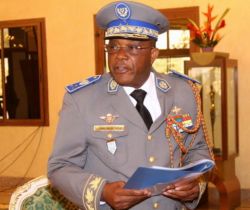 Honore TraoreThe events of 30 October 2014 came like a hammer blow for the ruling class. Within a matter of hours the revolutionary masses had overthrown both Compaoré and his handpicked successor, Honore Traore. Power was in the hands of the masses. But the leaders of Balai Citoyen, had no perspectives for events after Compaoré’s departure. This is the coalition of activists which were mobilising the youth which led the uprising. Their calls for a halt to mass mobilisations in the days after the exit of the despotic leader only served to sow confusion. It enabled the regime to temporarily find its footing.
Honore TraoreThe events of 30 October 2014 came like a hammer blow for the ruling class. Within a matter of hours the revolutionary masses had overthrown both Compaoré and his handpicked successor, Honore Traore. Power was in the hands of the masses. But the leaders of Balai Citoyen, had no perspectives for events after Compaoré’s departure. This is the coalition of activists which were mobilising the youth which led the uprising. Their calls for a halt to mass mobilisations in the days after the exit of the despotic leader only served to sow confusion. It enabled the regime to temporarily find its footing.
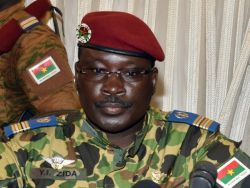 Isaac ZidaPower moved to Isaac Zida, a colonel from the Presidential Security Regiment. He immediately suspended the constitution. But this prompted fresh demonstrations two days after the start of the revolution. Feeling the ground shaking under his feet, he had to tread carefully. Then on 19 November, two weeks later, opposition parties, civil society groups and religious leaders appointed a civilian and diplomat, Michel Kafando, as interim president of a transitional government, but crucially they kept Zida in the dual role of prime minister and defense minister. The constitution were also re-established and Kafando and Zida were then tasked with guiding the country toward democratic elections on 11 October this year. To give himself cosmetic democratic credentials Zida, stepped down from his military duties and has since become a civilian.
Isaac ZidaPower moved to Isaac Zida, a colonel from the Presidential Security Regiment. He immediately suspended the constitution. But this prompted fresh demonstrations two days after the start of the revolution. Feeling the ground shaking under his feet, he had to tread carefully. Then on 19 November, two weeks later, opposition parties, civil society groups and religious leaders appointed a civilian and diplomat, Michel Kafando, as interim president of a transitional government, but crucially they kept Zida in the dual role of prime minister and defense minister. The constitution were also re-established and Kafando and Zida were then tasked with guiding the country toward democratic elections on 11 October this year. To give himself cosmetic democratic credentials Zida, stepped down from his military duties and has since become a civilian.
From the very beginning, the Kafunda-Zida government has been a government of crisis. Deep splits have opened up within the regime. This is a direct result of the pressure from the mass movement. Fearful of a second mass uprising, the Zida faction has been striking blows against leading members of Compaoré’s last government. Zida understands that if the most obvious and most reactionary Compaoré loyalists return to power after the elections, it could act as a provocation to the mass movement. The most intelligent section of the regime knows that at this stage the revolution still has all its reserves intact. The expectations of the masses are high. The October insurrection is still fresh in the minds of the masses. It is the dominant factor which has overshadowed the course of events for the last year. Therefore, the Zida faction is very careful to prevent any provocation which could spark a second wave of the revolution.
But the purging has resulted in fierce infighting which, in turn, has further destabilized the regime. One of the key battles over the last period has centred around the list of candidates for the elections. At the end of August, the Constitutional Council cleared 16 candidates which it said were “eligible” to stand. But the process of deciding on the list was fierce and acrimonious. In April, the transitional government changed the electoral law to exclude anyone who supported Compaoré’s bid to stay in office just before the revolution. On this basis the Constitutional Council declared 52 people ineligible for the elections.This included Eddie Constance Konboigo, the leader of Compaoré’s Congress for Democracy and Progress party.
The effect of this has been that the process now favours candidates who were formerly in the ranks of opposition during the Compaoré government. But although the majority of these candidates were opposing Compaoré formally, in reality they represented merely a different wing of the same regime. The majority of the candidates still come from the Compaoré era. For example, one of the frontrunners in the elections is Roch March Kabore, who was a loyal member of the regime before splitting away just before the revolution to form the People’s Movement for Progress (MPP). Kabore has strong links with the business sector. Another leading candidate is Zephirin Diabre, who founded his Union for Progress and Change (UPC) in 2010 after serving as Compaoré’s finance minister.
Alongside the issue over the electoral law, the transitional government has arrested leading members of Compaoré’s administration. Under the guise of fighting corruption, the transitional regime has been targeting numerous Compaoré-era cabinet members on charges of embezzlement of public finances. The two most noticeable cases are those of Jean Bertain Ouedraogo, a former infrastructure minister and Jerome Bougouma, a former security minister who were arrested in August and send to the main prison in the capital Ouagadougou. Shortly after this, former trade minister, Arthur Kafando also appeared in court on corruption charges. Another eight former ministers are also under indictment.
The threat of a coup
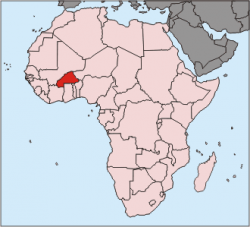 By excluding a large number of very powerful people from the electoral process, the Zida faction has managed to sideline a whole segment of the political establishment, notably those drawn from the Presidential Protection Regiment (RSP). These are largely the same people who have been responsible for most of the economic and political crimes under the last government.
By excluding a large number of very powerful people from the electoral process, the Zida faction has managed to sideline a whole segment of the political establishment, notably those drawn from the Presidential Protection Regiment (RSP). These are largely the same people who have been responsible for most of the economic and political crimes under the last government.
The RSP is the hated paramilitary unit which has been created to protect Blaise Compaoré during his 27 years in power. The unit was created to act as a counterbalance to the regular army. The 1983 left-wing coup was carried out by rank-and-file soldiers, who were themselves led by junior officers like Thomas Sankara. Compaoré himself was a leading member of the coup. More than anyone, he knew that in order to consolidate his counterrevolution of 1987, he needed to neutralise the junior officers. He did this by intentionally weakening the regular armed forces. He supplied it with the minimum amount of resources. The situation became so severe that he had all ammunition confiscated for a while after a mutiny which was put down in 2011.
On the other hand, he created the Presidential Protection Regiment (RSP), drawing its members from the most reactionary elements of the army. Huge resources were poured into this unit. They received the best training, the best equipment and higher benefits than the regular army with the help of the United States military. This has been confirmed recently by a spokesman for the United States Africa Command (AFRICOM). The RSP was never integrated into the military chain of command. Instead, the unit directly reported to the president.
Under Compaoré, the role of the RSP expanded from a bodyguard unit to a personal militia of the president. It became a bulwark of the counterrevolution. Critics and investigative journalists were kidnapped, murdered or simply disappeared.
The most significant example is that of the assassination of Norbert Zongo, an investigative journalist in 1998. Zongo was investigating the death of the chauffeur of Blaise Compaoré’s younger brother Francois, who was murdered in the presidential palace. On 13 December 1998, Zongo’s bullet ridden body and those of four other men were discovered in a burned out car 100 kilometers from Ouagadougou. This grisly discovery caused widespread revulsion in Burkinabé society. The mass demonstrations which followed, and the 2011 mutinies in the army indicated that Burkina Faso was already at that time in a pre-revolutionary situation. In August 2000, five members of the RSP were charged with the murder of Zongo. However, these charges were later dropped and Compaoré’s brother, Francois, never faced trial despite evidence that he was directly involved in Zongo’s murder.
When he came to power last November, Isaac Zida and the transitional government came under pressure from the masses who wanted justice for past crimes. He made many promises including bringing to justice the murderers of political figures in the Compaoré era. This brought him in direct conflict with very powerful people of the regime.
Every attempt to bring these people to justice has come up against a brick wall in the form of the RSP. The stand-off between the RSP and Zida reached boiling point. Zida threatened to disband the regiment and assign its officers to other posts. In response, the regiment demanded that president Michel Kafando dismissed Zida immediately.
On 4 February, the RSP blocked the entrance to the presidential palace and openly threatened to remove Zida from office. This threw the transitional government into crisis. Seeing a clear threat to the revolution, the masses responded with huge demonstrations on 7 February. Thousands of people marched through the streets with slogans calling for the RSP to be dissolved. The sight of the revolutionary people filling up Revolution Square in Ouagadougou was enough for the RSP officers and Zida to end the standoff.
However, the tension between Zida and the RSP soon resurfaced when reports came out that the elite soldiers were planning to arrest Zida after his return from a visit to Taiwan on 28 June. These reports were serious enough for Zida to land at a military airbase instead of the airport in the Ouagadougou. Later Zida announced that a plot against him was foiled, while the RSP commanders have accused Zida of inventing a “false coup.”
Ever since then, the regime has been on a political tightrope. This prompted president Kafando to intervene and appoint a “council of wise men” to mediate between his prime minister and the RSP. The RSP then announced that it was “putting itself completely in the president’s hands.” But a senior officer warned: “If he doesn’t make good decisions or takes too long, we’ll be forced to withdraw and let the soldiers do as they want. We can’t calm them down indefinitely.”
This is an ominous warning not just against Zida, but against the revolution itself. As long as the masses are the driving force behind events, the revolution will be propelled forward. But if the regiment is not dissolved and the revolution becomes stagnant, it can be used as a serious destabilising force. However, this should not be exaggerated. During the 2014 insurrection, the RSP were powerless to act against the mass movement. The masses simply brushed them aside when they were trying to prevent the demonstrators from entering the parliamentary grounds. This shows that in the revolutionary situation, when the masses began to move decisively, no amount of state repression could stop them.
The rediscovery of Sankara’s legacy
“While revolutionaries as individuals can be murdered, you cannot kill ideas.’’ -Sankara
The celebrated revolutionary hero Thomas Sankara was assassinated in a coup led by Blaise Compaoré on 15 October 1987. Compaoré was backed by the leaders of Ivory Coast and French imperialism. After four years in power, Sankara carried out the most far-reaching revolutionary programme in the history of the African continent. His policies of land expropriations and the nationalisations of key sectors of the economy broke the backs of the country’s ruling class. The agrarian reforms more than doubled wheat production which made the country completely self reliant. This made him the most important enemy for the continent’s ruling elites as well as their imperialist masters.
Although Burkina Faso is a small country, Sankara's revolution had a major impact on a number of other African countries. Sankara became more and more popular among the youth of the continent. He was followed by huge crowds everywhere he went. But his attacks on capitalism and French and US imperialism brought him into conflict with the imperialists as well as the reactionary African bourgeoisie.
To the horror of these leaders, Sankara began talking about spreading the revolution across the African countries. He created courts which could prosecute counter-revolutionaries not pursued and tried in other African countries. His speech at the summit of the Organisation of African Unity in Addis Ababa in 1987 where he called on African countries to follow the Burkanabé example and repudiate the IMF debt made him a very dangerous man for the imperialists and the African elite. Seeing his popularity growing among the masses, they began to deny him entry into their countries. Three months after his famous speech in Ethiopia he was assassinated.
But for the ruling class it was not enough to kill Sankara. Every attempt was made to dishonour him and eventually to erase him from the memory of the Burkanabé people. The new regime of Compaoré worked tirelessly to tarnish his memory. Every attempt was made to minimise his legacy. Those who dared to seek the truth were often tortured and murdered. In this way, the exact circumstances of Sankara’s death was never fully revealed and all attempts to pursue the matter were suppressed. The murder of Sankara and the attempt to get justice is therefore very important for the masses. It is a key demand of the revolution.
On 25 May, after a judicial order was granted,13 graves were opened in Dagnoen cemetery to establish whether or not the remains which were buried there included those of Sankara and others who were killed with him in the coup. But the exhumation of Sankara’s body is going hand in hand with the restoration of his legacy. Ouagadougou is awash with posters, videos and images of Sankara.
This is not limited to Burkina Faso. Across the African continent the legacy of Sankara is being rediscovered. Activists from Balai Citoyen have collaborated with their peers in Senegal, DR Congo and Burundi. For example, some of those arrested and deported during the student protests in DR Congo on 15 March against Joseph Kabila’s plans to delay elections and give himself more time in office, were youth leaders from Senegal’s Y’en a Marre and Burkina Faso’s Balai Citoyen. Y’en a Marre led the mass movement which brought down the increasingly authoritarian Senegalese president, Abdoulaye Wade in 2012. Like Balai Citoyen it cites Thomas Sankara as a revolutionary example.
The Sankarist parties
As we have seen, at the time of his assassination Thomas Sankara was moving in the direction of spreading the revolution to other African countries. But his short and intense life was cut short before any revolutionary party could be build. Therefore, with his assassination, the masses were completely unorganised. This allowed the counterrevolution of Blaise Compaoré to quickly and systematically liquidate any resistance.
But since the death of Thomas Sankara, numerous political parties claiming to believe in the “Sankarist” ideology have emerged but they have mostly been divided on the political scene. More than a dozen different “Sankarist” parties were formed in Burkina Faso after his death with the majority of these parties being little more than Sankarist sects. On 25 May, ten of these parties formed a unity agreement and put forward Benewende Sankara (no relation to Thomas Sankara) as a presidential candidate for the upcoming elections.
However, the most prominent group which follows Sankarist tradition is the Balai Citoyen. This is the popular movement led by reggae artist Sams’K Le Jah, rapper Serge Bambara Smockey and other artists, musicians and social activists. This movement played a crucial role in mobilising the youth on a massive scale in the run-up to the October insurrection. Although not a political party, Balai Citoyen has mobilised the masses around social issues such as corruption, power cuts and fuel price increases. It is likely to play important role in the coming struggle.
A new period
It is clear that the elections in October will solve nothing fundamental for the masses of Burkina Faso. It is likely that it will return to power the same rotten gang which has governed the country for the last 28 years. But it is equally clear that the capitalist system is incapable of solving the urgent needs of the masses. None of the political parties competing in these elections have a program addressing the crisis of food, housing and jobs.
On the other hand, the masses have shown their resolve to fight. The revolution has ushered in a new era of struggle in Burkinabé society. The expectations of the masses are high and they are aggressively pushing for an improvement in their lives. Through ferocious struggle, workers have wrestled important concessions from the bosses. Huge sections of the populations, especially the youth have rediscovered the revolutionary history of Sankara. The younger generation is hoping for a change in Burkina Faso. In this context, Burkina Faso is set for an explosion of the class struggle in the next period.

